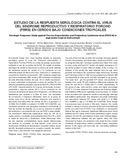Mostrar el registro sencillo del ítem
Estudio de la respuesta serológica contra el virus del síndrome reproductivo y respiratorio porcino (PRRS) en cerdos bajo condiciones tropicales
| dc.rights.license | http://creativecommons.org/licenses/by-nc-sa/3.0/ve/ | |
| dc.contributor.author | Kwiecien, Eduardo José | |
| dc.contributor.author | Mejía Silva, William | |
| dc.contributor.author | Zapata, Denice | |
| dc.contributor.author | Quintero Moreno, Armando | |
| dc.contributor.author | Gutierrez, Carolina | |
| dc.date.accessioned | 2017-11-03T17:07:53Z | |
| dc.date.available | 2017-11-03T17:07:53Z | |
| dc.date.issued | 2017-09 | |
| dc.identifier.issn | 0798-2259 | |
| dc.identifier.uri | http://www.saber.ula.ve/handle/123456789/43971 | |
| dc.description.abstract | El presente trabajo tuvo como finalidad estudiar la respuesta serológica contra el virus del Síndrome Reproductivo y Respiratorio Porcino (PRRS) en cerdos de granjas comerciales, mediante el uso de la prueba de ELISA. Se realizó un estudio serológico de cerdas en función de su número de parto, además de monitorear grupos de cerdos (3 a 21 semanas) en sus diferentes etapas de desarrollo (Inicio, Desarrollo y Finalización). La población muestral correspondió 1.287 muestras sanguíneas que fueron analizadas (430 cerdas y 857 lechones) procedentes de siete diferentes Estados del país. En el rebaño reproductor, la mayor positividad correspondió al grupo de paridad P0, con diferencia estadística respecto a las de paridad P5 y P6 (P= 0,034 y P= 0,047, respectivamente). En el grupo de lechones, la mayor positividad y mayores valores S/P = 1,0 se concentró en los lechones de las fases de desarrollo y finalización, con diferencias estadísticas con respecto a la fase de Inicio. Los resultados de Correlación y Regresión efectuados, tanto en el grupo de cerdas como en el de los lechones mostraron una relación y asociación muy débil entre los valores de S/P y la paridad (r = -0,1629, R2 = 0,0265) o la edad (r = 0,1655, R2 = 0,02726). Los resultados muestran una respuesta inmunitaria contundente al final del período de engorde, por lo que se presume un estado de reinfección o recirculación del virus de PRRS a esas edades. Se encontraron diferencias significativas entre los S/P de la región central y occidental, principalmente entre P4 y P6, y entre la etapa de desarrollo y finalización. Estas diferencias entre las dos regiones, probablemente hayan estado influenciadas por factores no revisados en este estudio, como serían las condiciones climáticas de temperatura, humedad relativa, época del año, densidad poblacional en la región y tamaño del rebaño, entre otros, y que ameritan una indagación adicional. | es_VE |
| dc.language.iso | es | es_VE |
| dc.publisher | SABER-ULA | es_VE |
| dc.rights | info:eu-repo/semantics/openAccess | |
| dc.subject | PRRS | es_VE |
| dc.subject | PRRSV | es_VE |
| dc.subject | Elisa | es_VE |
| dc.subject | Respuesta inmunitaria | es_VE |
| dc.subject | Serología | es_VE |
| dc.title | Estudio de la respuesta serológica contra el virus del síndrome reproductivo y respiratorio porcino (PRRS) en cerdos bajo condiciones tropicales | es_VE |
| dc.title.alternative | Serologic Response Study against Porcine Reproductive and Respiratory Syndrome virus (PRRSV) in pigs under tropical environment | es_VE |
| dc.type | info:eu-repo/semantics/article | |
| dc.description.abstract1 | The aim of this trial was to study the serologic response against Porcine Reproductive and Respiratory Syndrome (PRRS) virus by using the Elisa test. Serologic samples were taken from sows in every parity and from 3-21 weeks old piglets belonging to 31 pig farms located in seven different States of the Country. For analysis of the results, the data obtained from the pigs were grouped according to the production stage (Nursering, Growing and Finishing). A total of 1,287 serum samples were studied, 430 corresponding to sows group and 857 belonged to pig groups. The sows herd got the greatest S/P values and positivity in females from parity P0 with statistical differences between the parity P5 and P6 (P = 0.034 and P = 0.047, respectively). In the group of pigs, most positive values and higher percentage of S/P = 1.0 were obtained from growing and finishing stages, with statistical differences regarding nursering phase. In relation to the correlation and regression results in sow and pigs, although with statistic significances, they showed a very weak relationship and association between S/P values and parity (r = -0.1629, R2 = 0.0265) or age (r = 0.1655, R2 = 0.02726). Even though viral presence was not study in this work, however, the results showed a raising in immune response at the end of the fattening period, so some kind of PRRS virus reinfection or recirculation state at this age is presumed. Significant differences were found between the S/P values of the central and western region, mainly between P4 and P6, and between Grower and Finishing stages. These differences between the two regions, likely had been influenced by factors not reviewed in this study like the climatic conditions of temperature, relative humidity, season, population density in the region and herd size, etc., warranting additional studies in this field. | es_VE |
| dc.description.colacion | 282 - 293 | es_VE |
| dc.description.email | willian.mejia@fcv.luz.edu.ve | es_VE |
| dc.identifier.depositolegal | pp199102ZU46 | |
| dc.identifier.edepositolegal | ppi201502ZU4665 | |
| dc.identifier.eissn | 2477-944X | |
| dc.publisher.pais | Venezuela | es_VE |
| dc.subject.institucion | Universidad del Zulia (LUZ) | es_VE |
| dc.subject.institucion | Universidad de Los Andes (ULA) | es_VE |
| dc.subject.keywords | PRRS | es_VE |
| dc.subject.keywords | PRRSV | es_VE |
| dc.subject.keywords | Elisa | es_VE |
| dc.subject.keywords | Immune response | es_VE |
| dc.subject.keywords | Serology | es_VE |
| dc.subject.publicacionelectronica | Revista Científica | |
| dc.subject.seccion | Revista Científica: Medicina Veterinaria | es_VE |
| dc.subject.thematiccategory | Medio Ambiente | es_VE |
| dc.subject.tipo | Revistas | es_VE |
| dc.type.media | Texto | es_VE |
Ficheros en el ítem
Este ítem aparece en la(s) siguiente(s) colección(ones)
-
Revista Científica - 2017 - Vol.XXVII - No. 005
Septiembre - Octubre 2017


